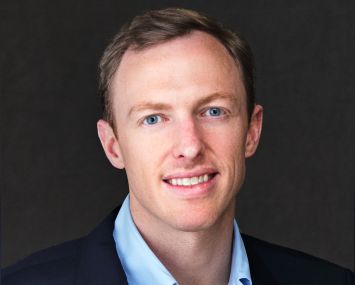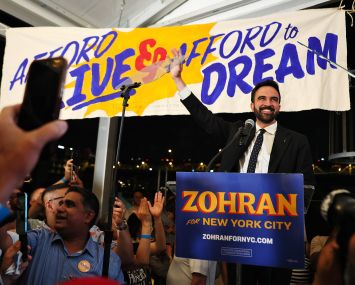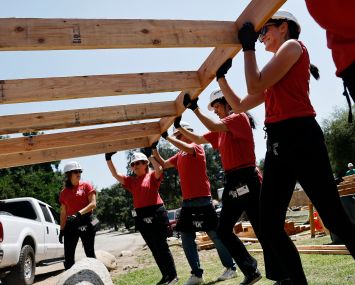Rockefeller Group’s Dan Rashin on MLB, 1271 Avenue of the Americas and Working in India
By Danielle Balbi April 12, 2017 9:00 am
reprints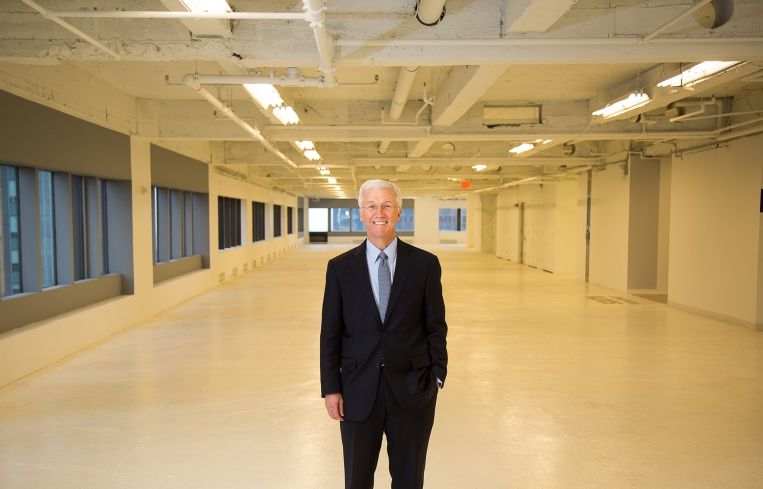
Armed with a spanking new degree from Harvard Law School, a B.A. in economics from Williams College and a couple of distinguished clerkships, Daniel Rashin began his legal career at a prestigious firm in Houston.
He lasted one trial. (More on that in a bit.)
For many of the bigwigs of real estate, the business is in their blood. Rashin, however, found real estate after making the decision not pursue a career in the law. Better to be cold-calling tenants and giving tours of empty office space.
The Wayland, Mass., native, who lives in New Canaan, Conn., sat with Commercial Observer, on one of the upper floors of 1271 Avenue of the Americas between West 50th and West 51st Streets—a building for which Rockefeller Group is in the middle of a staggering $600 million reimagining—and spoke about his career, from spending time managing developments in India to overseeing the Rockefeller Group’s portfolio (which spans across the country, with industrial properties in New Jersey and multifamily developments in Arizona). Now, the 61-year-old father of two is focusing his energies on Rockefeller Group’s two big undertakings: bringing 1271 Avenue of the Americas into the 21st century (don’t call it the Time & Life Building!) and finishing the 1.8-million-square-foot mega-development Flushing Commons.
Commercial Observer: How did you end up in real estate development?
Rashin: How much time do you have? Actually, I get calls from the undergraduate school that I went to. Juniors and seniors call me up and they’ll say, “I’m interested in real estate! How did you get into real estate?” And I say, “I can tell you, but it won’t help you.”
Basically, I tried my first case and decided that’s not what I wanted to do with my life. [A couple of friends] worked at Hines, a company I respected a lot. I ended up talking to them, and they took me through the buildings they had under development. I just found it fascinating. [One] guy took me in a building, starting at the very top at the cooling valves and went down all the way into the mechanical room. He said, “If your heart didn’t go pitter-patter through this tour, then you don’t belong in development.”
So we take it that your heart went with it.
Yeah! The hands-on of real estate development and building something physical and turning it into a place in the city really ended up attracting me. I didn’t look at a whole bunch of other industries. So that’s why I tell people I could tell you how I got there, but it’s not really going to help you in terms of how you think about it, because it was—in many ways—a series of happy coincidences.
What was that first case in which you decided you weren’t interested in being a lawyer?
It was an oil and gas case involving an underground blowout of a well and whether my client had misrepresented to a partner whether they had insurance to cover the underground blow-up. I can even remember some of the closing arguments I made.
Did you win or lose the case?
It was a split [decision]. So my client was happy, but I wasn’t.
What was your job when you started at Hines?
I ended up getting hired by Hines’ New York office. The price of oil collapsed and Houston’s economy was really kind of shaky back then. New York—this is 1985—was still on a very good upward trajectory and Hines was developing the Lipstick Building [at 885 Third Avenue]. I was hired to be the assistant leasing manager, so I was tasked with taking brochures, going out and cold calling and then giving tours. I did that for a couple of years, and then I got into the project management side of the business.
Dare we ask the controversial Lipstick question? Did you meet [Ponzi king] Bernie Madoff [whose offices were in the building] while you worked there?
I was introduced to him once in a group. We were walking through his space as it was being built out. He was chewing out attending construction men. That was my only meeting with Bernie Madoff.
You eventually became CEO of one of [Lendlease’s] businesses. How did that happen?
I was a project manager for Hines. I worked on the renovation of one of the old post offices in Washington, D.C., for a little while. I worked on the Bristol-Myers Squibb project in Princeton, N.J. In 1992 and 1993, we hit the downturn so things on the development side stopped.
I worked with our Houston office, looking at how to tap pension fund money and become an investment manager slash asset manager given that the development business was slowing down.
Then, I was approached about going to The Yarmouth Group—actually a decent-sized investment manager back then—about getting into the investment management business. And so I joined The Yarmouth Group in 1994 and worked on asset-management-slash-investment-management here in New York. In 1997, I was transferred down to Sydney, Australia, as the CEO of their Australian investment management business. I did that for two-and-a-half years. And then I moved to London and became CEO of their European and U.K. investment management business.
Did you like living in Sydney and London?
They were not hardship posts. Sydney is the nicest place I will ever have lived in terms of the climate. I was an expat, so I lived in a house I couldn’t afford. And I had a short commute to work, going to the Harbor Bridge every day, looking at the Opera House. Ten-minute walk to the beach. I love the outdoors, as do my wife and kids, so, for us, it was just a great, great spot.
London was a lot of fun as well, but it was completely different. Instead of living outside, we were living inside. But you had all the advantages of a great city. The museums, the culture…We did not live 10 minutes from the beach [laughs], but it was also a fabulous place to live.
But I was only there for a year-and-a-half, and then we moved back to the U.S., and I rejoined Hines. They had started an investment management business, and they had a joint venture with CalPERS as national office partners. I was [put] in charge of the eastern half of the country and then later on became the portfolio manager for the CalPERS venture and the portfolio manager for the Hines-CalPERS Green Development line. We started up a separate development fund with them with a focus on green investing. LEED [Leadership in Energy and Environmental Design designation] was new and all that. I did that until 2010. And then, I did a year with Hines going back and forth to India. That’s a long commute.
What were you doing in India?
Hines started an India fund and they were in the process of transitioning the office from expat management to local management. I would go back and forth and just help with the transition and be there as a resource for the local guys who were working on two significant projects. One was basically a 1-million-square-foot high-rise, and then the other was a two-building suburban development. I did that for about a year. In the middle of 2012, I transitioned out of Hines, and in fall 2012, I did a few consulting assignments for the Rockefeller Group. And at the beginning of 2013, I was hired on full-time at the Rockefeller Group.
What was development like in Australia or the U.K. versus America?
In London, I wasn’t involved in any development because we were trying to build the investment management side of the business. In Australia, I did see development there and it was very similar to the United States. The way they finance things was a little different.
India was much, much different. You didn’t have the same history, the same quality of materials, or the same quality of architecture. Hines was trying to do something much different and bring in Robert A.M. Stern to do the architecture. But that was a different sort of thing. Amenities and buildings were different.
Ownership was a whole lot different. A lot of Indian development was financed by what they call “Strata Title,” which is really condominium ownership. So we had an office that was [let’s say] 15,000 feet with four different landlords. If you have all these different owners, it’s very hard to spend money on capital improvements. If you need a new lobby, you’ve got a 5,000-foot owner up on the fifth floor who says, “I’ve got the lease for the next 10 years. Why would I want to spend money on a new lobby?”
Rockefeller Group has had a tremendous year when it comes to leasing along Avenue of the Americas, it seems, especially with the signing of Major League Baseball at 1271. How did you attract a tenant like that?
The reason that MLB and others are looking at this building is because of our commitment in the investment. We were competing, and we do compete, with a lot of new product now. To compete with Hudson Yards, to compete with Downtown… And with the modern office user—today’s office user—they want modern buildings. They want systems that work. They want open spaces.
When we were looking at Time leaving this building, you really had a fork in the road. You can become two things, at least in my mind. You could compete, or you decide you don’t have to make that investment and you become more of a commodity space competing for tenants basically on the basis of price. And, obviously, we chose what in total is a $600 million project here to modernize the space. We’re lowering the convectors, raising the windows so you have a much bigger window area and a lot more light coming into the space. And instead of this cramped old view, you’ve got a much bigger view. We’re upgrading all of the systems. For MLB—who looked at the West Side, Hudson Yards, I’m sure they looked Downtown—they wanted to consolidate operations between the MLB commissioner’s office and MLB Advanced Media.
When did you make the decision that you were going to overhaul the property?
One of the first things I started looking at when I joined in 2013 was what we were going to do with 1271. The Time & Life lease technically expires at the end of this year, so [at the time] it was still a good five years ahead of [the lease’s expiration]. Even if they stayed, they were going to be occupying a fraction of the space they had, so we had to ask the question, “What do you have to believe in order to make that investment make sense? Does it make sense to spend all of that money to reposition the building? What type of tenants do you believe you can get? What kind of rents do you believe they would pay?” And then compare that to if you don’t do anything.
Is there a lot of interest from prospective tenants for this building?
Yeah. The smallest tenants we’re really focused on now would be 12,500 to 15,000 square feet because we have 1.5 million square feet to lease. We’re very proud of the fact that we have at least 400,000-square-feet leased, but we still have 1.5 million to go. We need to accommodate the larger users, and then the smaller ones we’ll fill in. [The tenant mix] has been exactly what you’d expect: some [technology, advertising, media and information companies], some law firms, some finance. We’ve had a couple of the Fortune 500-type of firms. You’ve got a big space, you’ve got a modern building and a great location. So we’re going to see all the big deals.
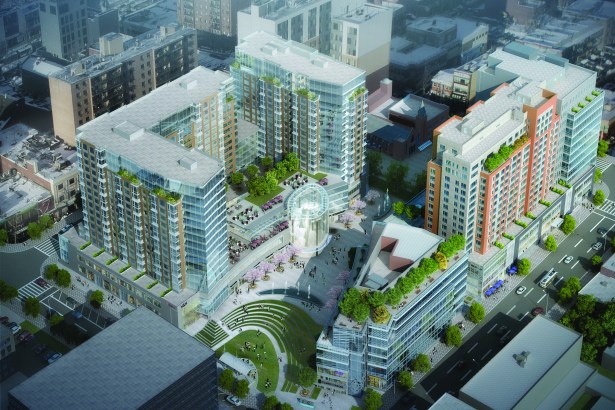
Let’s switch gears and talk about ground-up development. What’s the latest with Flushing Commons?
We have temporary certificates of occupancy, I think, for all of it. We’re waiting for final sign-offs from various [city] departments before we start closing. We have sold all but two of the commercial units, and we have maybe three residential units left. Basically we are at 98 to 99 percent sold and have been for months. And the prices we’ve achieved, I’m pretty sure that they make records on both the office and the residential side.
We’ve started our retail leasing and the response has been really strong from the retail tenants. The types of rents that we’re getting are somewhere in the order of 75 percent higher than we hoped. Then we have Phase 2, which is actually almost twice the size of Phase 1. At this point we’re trying to figure out how and when we start on Phase 2.
Flushing is interesting because you have a mix of big commercial tenants with a lot of mom-and-pop shops. Are you getting interest from experienced retailers or newcomers?
We’re seeing a mix. Everything from banks to those telecommunication outlet-type stores to established restaurants or food providers that want to have another location. We haven’t seen that much apparel. We’ve seen some that would be a good ancillary use to the medical component of our office buildings, because we’ve sold a number of the commercial units to doctors.
What kind of impact do you think Flushing Commons is going to have on the area as a whole?
In my mind, two things: One, we did try to raise the bar in terms of quality. That’s what developers do. The quality [of development] in Flushing is getting greater and greater, so you’ve got to continue to do that. I think the biggest impact on Flushing will be when we finish Phase 2 and provide that open space as a public amenity, and as something to help Flushing define a center, a gathering place.
